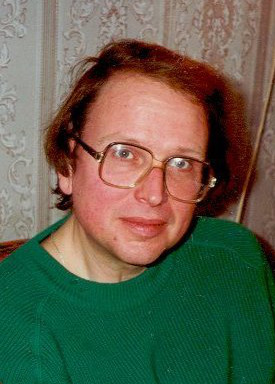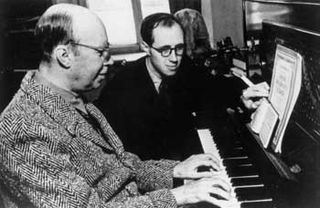
Mstislav Leopoldovich Rostropovich was a Russian cellist and conductor. In addition to his interpretations and technique, he was well known for both inspiring and commissioning new works, which enlarged the cello repertoire more than any cellist before or since. He inspired and premiered over 100 pieces, forming long-standing friendships and artistic partnerships with composers including Dmitri Shostakovich, Sergei Prokofiev, Henri Dutilleux, Witold Lutosławski, Olivier Messiaen, Luciano Berio, Krzysztof Penderecki, Alfred Schnittke, Norbert Moret, Andreas Makris, Leonard Bernstein, Aram Khachaturian, and Benjamin Britten.
The Cello Concerto No. 2, Op. 126, was written by Dmitri Shostakovich in the spring of 1966 in the Crimea. Like the first concerto, it was written for Mstislav Rostropovich, who gave the premiere in Moscow under Yevgeny Svetlanov on 25 September 1966 at the composer's 60th birthday concert. Sometimes the concerto is listed as being in the key of G, but the score gives no such indication.
Steven Isserlis is a British cellist. He has had a distinguished career as a soloist, chamber musician, educator, author and broadcaster. Acclaimed for his profound musicianship, he is also noted for his diverse repertoire, command of phrasing, and distinctive sound which is deployed with his use of gut strings.
Emil Grigoryevich Gilels was a Russian pianist. He is widely regarded as one of the greatest pianists of all time.
Sergei Prokofiev's Symphony-Concerto in E minor, Op. 125 is a large-scale work for cello and orchestra.

Nikolai Yakovlevich Myaskovsky or Miaskovsky or Miaskowsky, was a Russian and Soviet composer. He is sometimes referred to as the "Father of the Soviet Symphony". Myaskovsky was awarded the Stalin Prize five times.

The Cello Sonata No. 3 in A major, Op. 69, is the third of five cello sonatas by Ludwig van Beethoven. He composed it in 1807–08, during his productive middle period. It was first performed in 1809 by cellist Nikolaus Kraft and pianist Dorothea von Ertmann, a student of Beethoven. Published by Breitkopf & Härtel the same year, it was dedicated to Freiherr Ignaz von Gleichenstein, Beethoven's friend and an amateur cellist. The sonata was successful with audiences from the beginning.

David Geringas is a Lithuanian cellist and conductor who studied under Mstislav Rostropovich. In 1970 he won the gold medal at the International Tchaikovsky Competition. He also plays the baryton, a rare instrument associated with music of Joseph Haydn.

Sergei Prokofiev's Symphony No. 7 in C-sharp minor, Op. 131, was completed in 1952, the year before his death. It is his last symphony.

The Piano Trio No. 2 in E minor, Op. 67, is a piece for violin, cello and piano by the Russian composer Dmitri Shostakovich, started in late 1943 and completed in August the following year. It was premiered on 14 November 1944. The piece was dedicated to his close friend Ivan Sollertinsky, whose death in February 1944 affected Shostakovich profoundly.

Sergei Rachmaninoff's Sonata in G minor for Cello and Piano, Op. 19 was completed in November 1901 and published a year later.
Cello Concerto in E minor, Op. 58 is a concerto written by Sergey Prokofiev between 1933 and 1938. Its duration is approximately 35 minutes. It consists of three movements:
- Andante – Poco meno mosso – Adagio
- Allegro giusto
- Tema (allegro) – Interludio 1 – Variations 1–3 – Interludio 2 – Variation 4 – Reminiscenza – Coda – Più mosso
Sergei Prokofiev's Cello Concertino in G minor, Op. 132 was left incomplete at the composer's death in 1953. It was completed by Mstislav Rostropovich and Dmitry Kabalevsky.

Alexander Ivashkin, was a Russian cellist, writer, academic and conductor.
Vladimir Mikhailovich Blok was a Russian musicologist, composer and orchestrator of the works of Prokofiev, of Udmurt ethnicity.

Rudolf Borisovich Barshai was a Soviet and Russian conductor and violist.
The Piano Sonata No. 9 in C major, Op. 103 by Sergei Prokofiev is his final completed piano sonata. It is dedicated to pianist Sviatoslav Richter.
The Sonata for Viola and Piano, Op. 147, is the last composition by Dmitri Shostakovich. It was completed on July 5, 1975, weeks before his death. It is dedicated to Fyodor Druzhinin, violist of the Beethoven Quartet.

The Cello Sonata in C major, Op. 119, was composed by Sergei Prokofiev in 1949. The year before, Prokofiev was accused of formalism by the Zhdanov Decree and much of his music was banned. However, he continued to compose music, though he was not sure if his new works would ever be performed in public.










